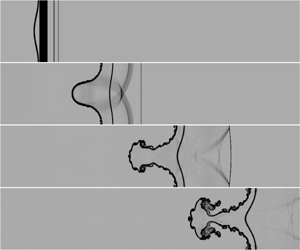Article contents
Interfacial instability at a heavy/light interface induced by rarefaction waves
Published online by Cambridge University Press: 07 January 2020
Abstract

The interaction of rarefaction waves and a heavy/light interface is investigated using numerical simulations by solving the compressible Euler equations. An upwind space–time conservation element and solution element (CE/SE) scheme with second-order accuracy in both space and time is adopted. Rarefaction waves are generated by simulating the shock-tube problem. In this work, the SF6/air interface evolution under different conditions is considered. First, the gas physical parameters before and after the rarefaction waves impact the interface are calculated using one-dimensional gas dynamics theory. Then, the interaction between the rarefaction waves and a single-mode perturbation interface is investigated, and both the interface evolution and the wave patterns are obtained. Afterwards, the amplitude growth of the interface over time is compared between cases, considering the effects of the interaction period and the strength of the rarefaction waves. During the interaction of the rarefaction waves with the interface, the Rayleigh–Taylor instability induced by the rarefaction waves is well predicted by modifying the nonlinear model proposed by Zhang & Guo (J. Fluid Mech., vol. 786, 2016, pp. 47–61), considering the variable acceleration. After the rarefaction waves leave the interface, the equivalent Richtmyer–Meshkov instability is well depicted by the nonlinear model proposed by Zhang et al. (Phys. Rev. Lett., vol. 121(17), 2018, 174502), considering the growth rate transition from Rayleigh–Taylor instability to Richtmyer–Meshkov instability. The differences in the heavy/light interface amplitude growth under the rarefaction wave condition and the shock wave condition are compared. The interface perturbation is shown to be more unstable under rarefaction waves than under a shock wave.
JFM classification
- Type
- JFM Papers
- Information
- Copyright
- © The Author(s), 2020. Published by Cambridge University Press
References
- 21
- Cited by




